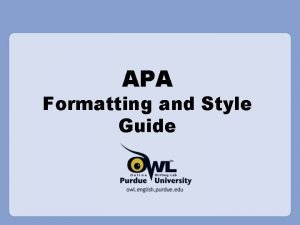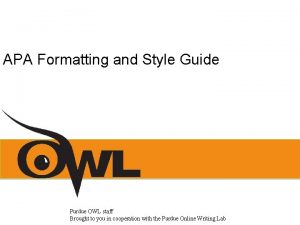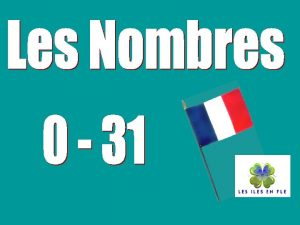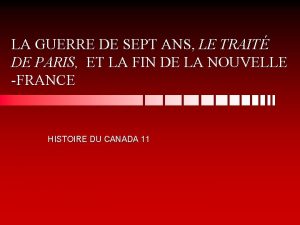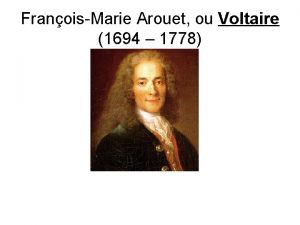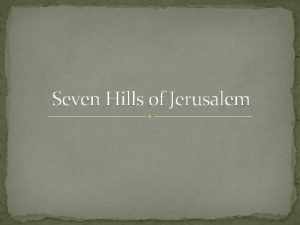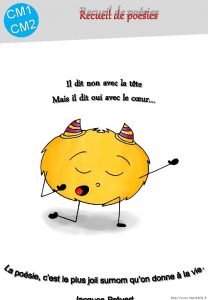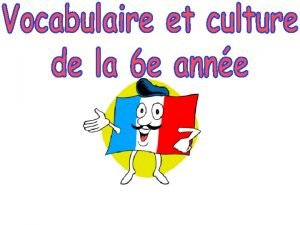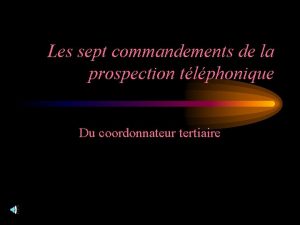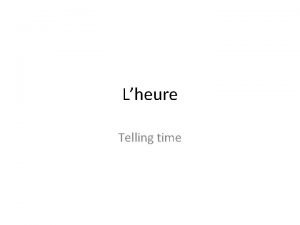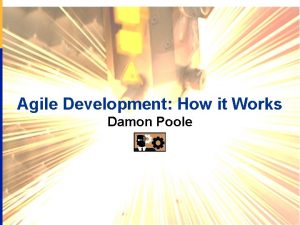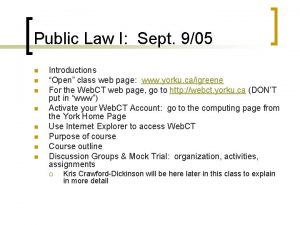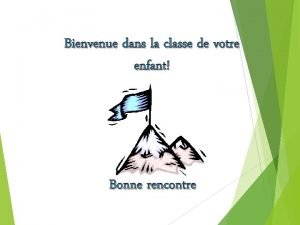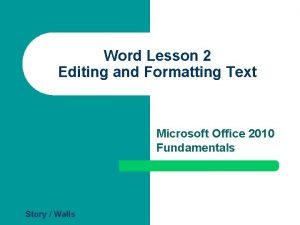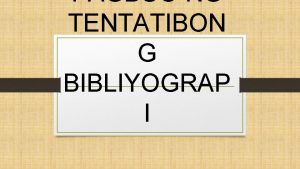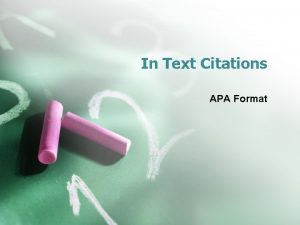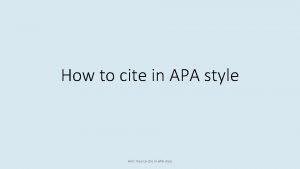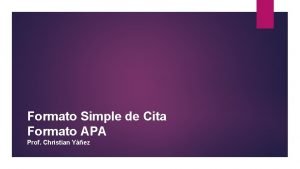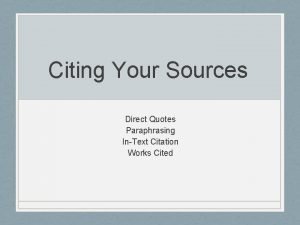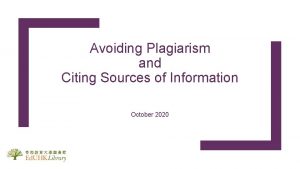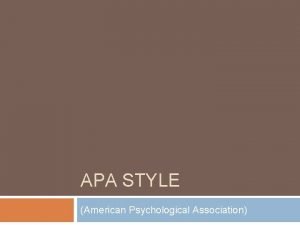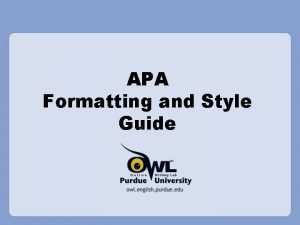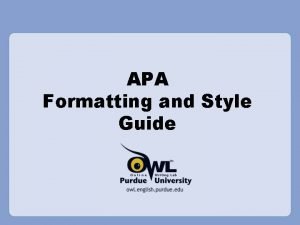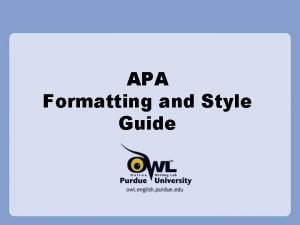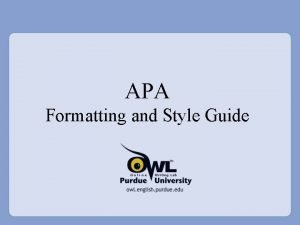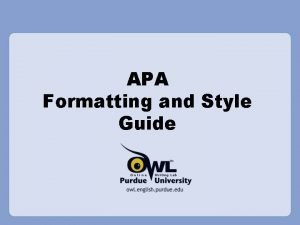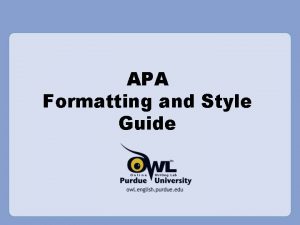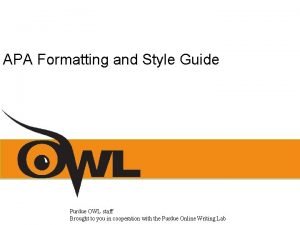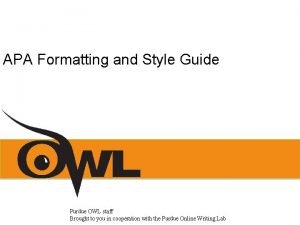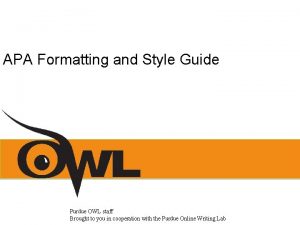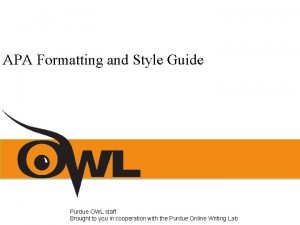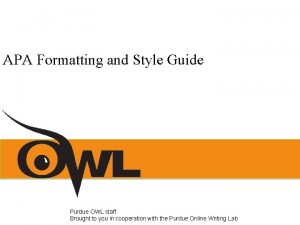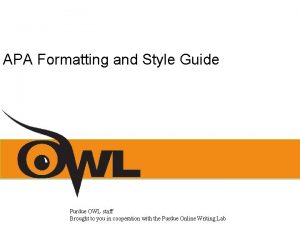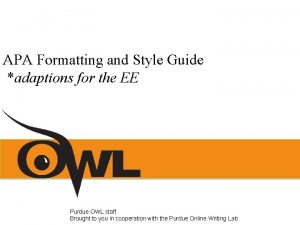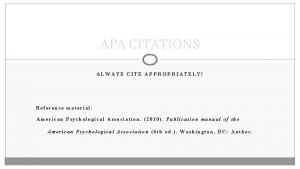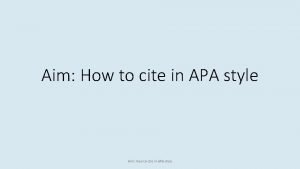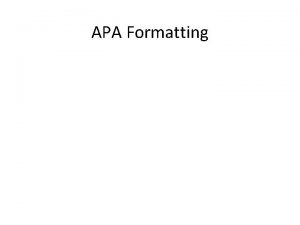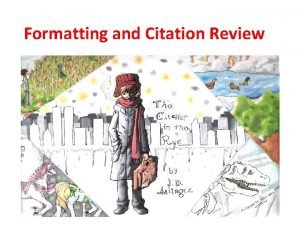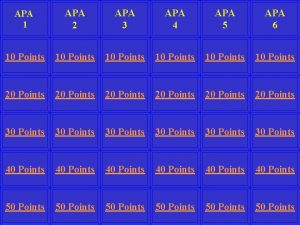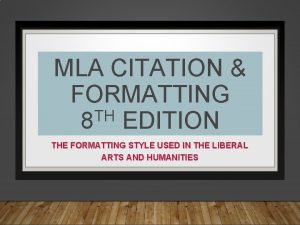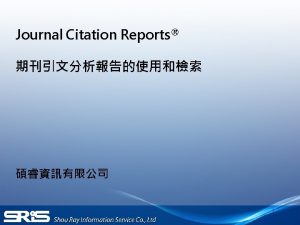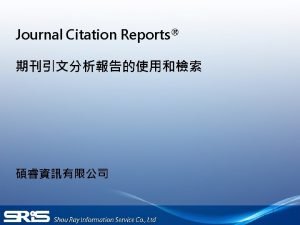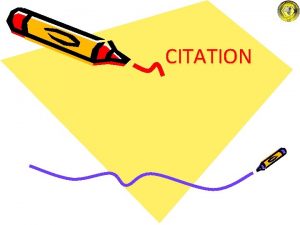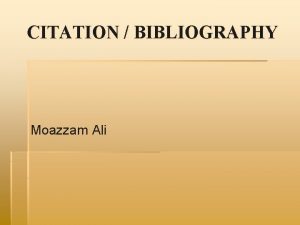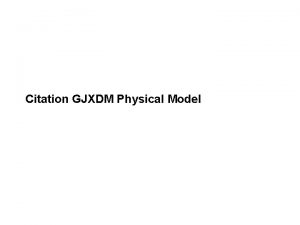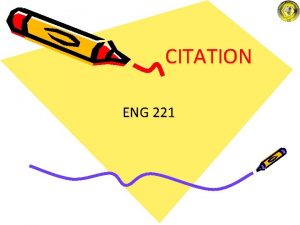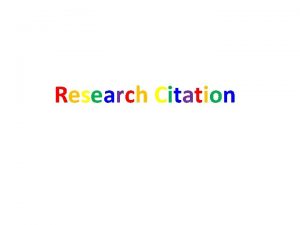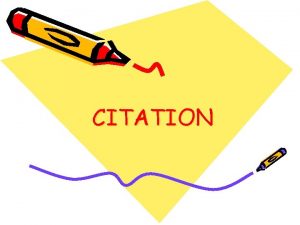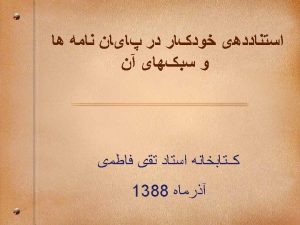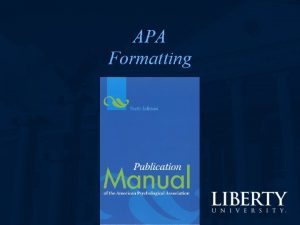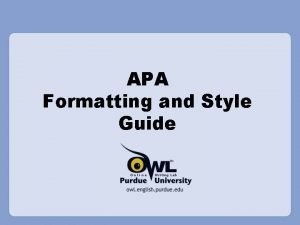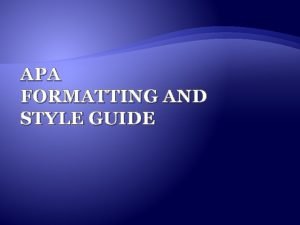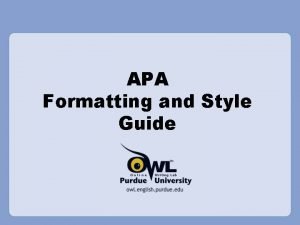APA formatting and citation An introduction Sept 2015
















































- Slides: 48

APA formatting and citation An introduction Sept. 2015

What is APA? APA Style is the format of citation and referencing most commonly used in the social sciences.

Three aspects I. Format (arrangement) of the page II. In-text citations III. References page

I. Page Format Every page must contain: • a running head at the top • the running head appears in the top margin • a page number in the top right-hand corner • you need a number only; no need for “pg. ” or “p. ” • see example on next page

I. Page Format: Title page Running head: TITLE IN ALL CAPITALS Your own assignment title Student name Course name and Section # Assignment # Nor. Quest College Instructor’s Name Due Date #

I. Page format Running head Info in center of page Your own title Student name College Name Course name and section # Instructor’s name Assignment # Due Date page number in upper right hand corner

I. Page Formatting: Headers • Use the “Header” feature in Word • Running head on p. 1 includes the words “Running head: ”. All other pages do not. Title page Running head: EFFECTS OF FORMALITY 1 EFFECTS OF FORMALITY Subsequent pages 2 3

I. Page formatting: Headers • double click the top of the page • check option for “Different First Page”

I. Page Formatting For more detailed instructions on formatting documents in APA: • see the section on “Setting up Word for APA” in the class Moodle • Go to the Nor. Quest library website APA guide

I. Page Formatting • • One-inch margins Times New Roman font, size 12 double spaced align left IMPORTANT: Ensure that on every page your running heads and page numbers are consistently in Times New Roman

Formatting: The Body • text is double spaced • Times New Roman 12 point font (includes running head and page numbers) • indent first line of each paragraph 0. 5 inches • no extra spaces between paragraphs • title at the beginning of the assignment

Formatting: Assignment page

Three aspects I. Format (arrangement) of the page II. In-text citations III. References page

II. In-text citations When quoting another source, you must include a parenthetical in-text citation. For professional Italian soccer clubs, “attendance plays no role in the winning performance” (Armenta & Betta, 2010, p. 76). citation

II. In-text citations There is a connection between citations and the reference page. Each citation refers to an entry in the reference page. Everything cited must be in the reference page and everything in the reference page must have been cited.

II. In-text citations A citation can have three parts within the parentheses (): • author last name(s) • publication year • page number The presence of crowds has no effect on the performance of professional soccer clubs (Armenta & Betta, 2010, p. 76).

II. In-text citations However, if you have already mentioned the author(s) in the paragraph, the publication year (in parentheses) follows and all that remains in the citation is the page number. According to Armenta and Betta (2010), for professional Italian soccer clubs, “attendance plays no role in the winning performance” (p. 76). citation The author(s) and publication year always go together in the body text: Armenta and Betta (2010).

II. In-text citations When quoting directly, you must include the page number. According to Armenta and Betta (2010), for professional Italian soccer clubs, “attendance plays no role in the winning performance” (p. 76). (author names in paragraph) For professional Italian soccer clubs, “attendance plays no role in the winning performance” (Armenta & Betta, 2010, p. 76). (author names in citation)

II. In-text citations You can also paraphrase another source. Paraphrasing is putting information into your own words. Even though the words are yours, the ideas are not, so a citation is still required.

II. In-text citations APA does not require a page number when paraphrasing. Others have studied the correlation between attendance at soccer matches and outcomes (Armenta & Betta, 2010). However, if the information you are paraphrasing is specific, it helps the reader if you include a page number. Crowds have no effect on the performance of professional soccer clubs (Armenta & Betta, 2010, p. 76).

II. In-text citations If the text does not have page numbers, use paragraph numbers instead. In the system of “total football”, “all 11 players, including the goalkeeper, were responsible for keeping the ball moving forward” (Burns, 2011, para. 7).

II. In-text citations Formatting Quirks Note the punctuation: Citation goes BEFORE the period. Others have studied the correlation between attendance at soccer matches and outcomes (Armenta & Betta, 2010). * To remember this rule, treat the citation as an essential part of the sentence, which means that it belongs with the sentence, that is, before the period (not after). In the citation: If there is more than one author, use an ampersand (&) instead of the word “and”.

II. In-text citations If there are three to six authors: For the first citation include all the last names. first time: (Jones, Scholes, & Ferguson, 2004) For all the subsequent citations, use the first author’s last name followed by et al. and a comma. second time and after: (Jones et al. , 2004) et al. is short for et alia, which is Latin for “and others”

II. In-text citations If the quotation is more than 40 words, set it off as a block quotation. The jump from programming robots with soccer skills to using them in more challenging environments will be difficult to overcome. A house or apartment and the possessions it contains (which can act as landmarks) may not change much over time, but it is more complex to move about in. It is harder still for an AI program to map a completely unfamiliar urban environment without any immediately identifiable landmarks. (Cohen, 2011, p. 10) Cohen is still optimistic about the prospects, however.

II. In-text citations: Block quotations For block quotations: • quotations that are 40 words or more need to be reformatted as block quotations • start a block quotation on a new line; every line should be indented 0. 5 inches • no need for quotation marks, since the indentation already indicates that it is a quote • the citation goes AFTER the period at the end

I. In-text citations: The Broadview Anthology of Expository Prose Our class anthology, The Broadview Anthology of Expository Prose, is cited in an unusual way because it consists of reprinted material that was originally published in other sources. Essentially, each reading in the anthology has two publication dates: 1) the original date of publication and 2) the date that The Broadview Anthology (the book) was published.

I. In-text citations: Broadview Anthology To cite a reading from our anthology, include both dates in chronological order, separated by a slash (/) The Flynn effect describes the statistical rise of I. Q. scores over time. (Gladwell, 2007/2011, p. 544). Author name in citation original publication year The Broadview Anthology of Expository Prose publication year Gladwell (2007/2011) defines the Flynn effect as the statistical rise in I. Q. scores over time (p. 544). Author name in sentence

Three aspects I. Format (arrangement) of the page II. In-text citations III. References page

III. References page All cited sources appear in the References page at the end of the essay

III. References page Starts on a new page. The reference page is listed alphabetically by author last name. It is double spaced with a hanging indent (first line is flush against the left margin and all subsequent lines of the same entry are indented 0. 5 inches) No extra spaces between entries

III. References page: Titles For longer works like books, journals, and magazines: 1. Italicize the title. Newsweek (magazine) Scientific American (magazine) International Business and Management (journal) Principles of manual sports medicine (book) Intersections: Readings in the sciences and humanities (book) 2. Note the different rules about capitalization: • Capitalize the important words in journal and magazine titles • Capitalize only the first word in titles of books, and any word that immediately follows a colon.

III. References page: Titles For shorter works like articles (in journals, magazines, books): 1. Do not format the title at all. This means no italics and no quotation marks. 2. Capitalize only the first word any word that immediately appears after a colon (: ). Waiting for a goal. You can even walk alone: Stadium attendance and professional soccer clubs’ social role. These rules formatting titles apply to the References page only. The rules formatting titles in the body text of your essay are different.

II. References page: Titles In the References page: Kolbert, K. (2011). The sixth extinction? [title not capitalized, and without quotation marks] In the body text: In “The Sixth Extinction”, Kolbert (2009/2011) describes… [title capitalized, with quotation marks]

II. References page: Titles In the References page: Karageanes, S. (2005). Principles of manual sports medicine [title italicized and not capitalized] In the body text: In Principles of Manual Sports Medicine, Karageanes (2005) describes… [title italicized and capitalized]

References page: Capitalization A review of capitalization rules for the References page Always capitalize: -all words at the beginning of a title -any word that appears immediately after a colon -proper nouns (i. e. , a name that is always capitalized, like a person’s name or the name of a city or country) For book titles, capitalize the first word, any word that immediately follows a colon, and any proper noun. For journal titles, and titles of other periodicals, capitalize all important words. For journal article titles, capitalize the first word, any word that immediately follows a colon, and any proper noun.

III. References page For each kind of source, the structure for a References page entry is the same. Identify the kind of source you are dealing with, and use the examples provided in these notes and on the library website as a template. A helpful resource to consult is APA guide created by the Nor. Quest library, which provides examples of how to cite and format a variety of sources.

III. References page For a book: Author, A. A. (Date). Title in italics. Place of publication: Publisher. Karageanes, S. J. (2005). Principles of manual sports medicine. Philadelphia, PA: Lippincott Williams & Wilkins.

III. References page For an article or chapter in an edited book with multiple contributors list editors and authors in the order that they appear on the title page Author, A. A. (Date). Title of article. In T. Editor, E. Editor, & V. Editor (Eds. ), Title of book collection (volume, edition, pages). Place of publication: Publisher. Balakas, K. , & Letourneau, N. (2009). Developmental theories. In P. A. Potter, A. G. Perry (Eds. ), J. C. Ross-Kerr, & M. J. Wood (Canadian Eds. ), Canadian fundamentals of nursing (4 th Canadian ed. , pp. 312 -397). Toronto, ON: Mosby Elsevier.

References Page: The Broadview Anthology As we saw with in-text citations, The Broadview Anthology of Expository Prose presents a special case when it comes to APA because the book contains material that was originally published elsewhere. The Broadview Anthology of Expository Prose is considered a source that contains reprinted material.

III. References Page: The Broadview Anthology A References entry for a reading in The Broadview Anthology of Expository Prose contains two sets of publication information. Begin with the information about The Broadview Anthology, and then include the original publication information in parentheses at the end. (see example on next page) You can find the original date at the end of the reading, and more original publication information in the Acknowledgements section beginning on page 705.

III. References Page: The Broadview Anthology of Expository Prose Article in a book with reprinted material from a magazine or journal in a collection (blue indicates information related to The Broadview Anthology, brown indicates information for the original publication) Editors of collection/ anthology Author Title of Martin, E. (2011). The egg and the sperm. In L. Buzzard, J. collection Broadview Anthology Article title publication year Broadview place of publication Gaunce, D. Le. Pan, M. Moser, & T. Roberts (Eds. ), The Broadview anthology of expository prose (2 nd ed. , pp. 347– 364). Peterborough, ON: Broadview Press. (Reprinted from Signs: Journal of Women in Culture and Society 16(3), 1991) volume and issue number of journal (for a magazine, use year and month of publication original publication year title of article’s original publication source Additional publication info of article in Broadview edition Broadview Anthology publisher

III. References Page: The Broadview Anthology Article in a book with reprinted material from a book in a collection Author Editors of collection Broadview Anthology place of publication Broadview Anthology Article title publication year Harris, M. (2011). Pig lovers and pig haters. In L. Buzzard, J. Gaunce, D. Le. Pan, M. Moser, & T. Roberts (Eds. ), The Broadview anthology of expository prose (2 nd ed. , pp. 185– 199). Peterborough, ON: Broadview Press. (Reprinted from Cows, pigs, wars, and witches, New York: Random House, 1974) original publisher original publication year title of original source Title of collection Additional publication info of Broadview article Broadview Anthology publisher original place of publication

III. References page For a journal article Italicize volume # no space between volume # and (issue #) Author, A. , Author, B. , & Author, C. (Date). Title of article. Journal Title in Italics, Vol. #(Issue#), page numbers. Armenta, C. , & Betta, P. D. (2010). You can even walk alone: Stadium attendance and professional soccer club’s social role. International Business and Management, 1(1), 69 -79. Note: do not use “pp. ” for the page numbers of journal articles. Include the numbers only.

III. References page A DOI (Digital Object Identifier) is a string of letters and numbers that is unique to a published source. It is like a serial number for research. If the book or article was retrieved through library databases, either a DOI or a URL must be provided. Usually articles will have a DOI (a digital object identifier). If there is no DOI, see p. 8 of the Nor. Quest library APA Quickguide or this page for which URL to use. Remember, if you have a DOI, you do not need the URL.

III. References page The DOI (or the URL) appears at the end of the entry. It uses the format doi: xxxxx Note the lower case “doi”, the lack of a space between the colon and the number itself, and the lack of a period at the end. Kesselheim, A. S. (2011). Covert pharmaceutical promotion in free medical journals. CMAJ: Canadian Medical Association Journal, 183(5), 534 -535. doi: 10. 1503/cmaj. 110156

III. References If the article was accessed through a database but does not have a DOI, use one of the URLs provided in the Nor. Quest Library’s APA Guide (Click on “References, ” then select “Database Articles”) Kesselheim, A. S. (2011). Covert pharmaceutical promotion in free medical journals. CMAJ: Canadian Medical Association Journal, 183(5), 534 -535. Retrieved from http: //infotrac. galegroup. com/itweb/edmo 88243? db=H WRC

III. References page Magazine articles (print) Author, A. (Date). Title of article. Magazine Title, Vol. #(Issue#), pages. Surowiecki, J. (2011, August 1). Smash the ceiling. The New Yorker, 87(22), 23.

If you are not sure… Nor. Quest library APA Guide: http: //libguides. norquest. ca/apa 6 Purdue University’s Online Writing Lab (OWL): http: //owl. english. purdue. edu/owl/section/2/10/ The APA Publication Manual (6 th edition): http: //www. apastyle. org/manual/ (Available for loan in your library)
 Apa introduction example
Apa introduction example Abstract page apa
Abstract page apa Apa format purdue owl
Apa format purdue owl Un deux trois quatre cinq six sept huit neuf
Un deux trois quatre cinq six sept huit neuf Deportes
Deportes Candide ou l optimisme
Candide ou l optimisme Hills of jerusalem
Hills of jerusalem Illustration poésie le blaireau sans-gêne
Illustration poésie le blaireau sans-gêne Ecrivez les sept jours de la semaine
Ecrivez les sept jours de la semaine Sept commandements
Sept commandements Cnn10 september 7
Cnn10 september 7 Sept heure moins le quart
Sept heure moins le quart Accu poole sept
Accu poole sept Ectomy examples
Ectomy examples Sept
Sept I sept
I sept Sept comme setteur questionnaire
Sept comme setteur questionnaire Arrow font
Arrow font Magnetic read and write mechanisms
Magnetic read and write mechanisms Quote citation
Quote citation Chinese name apa citation
Chinese name apa citation How to reference a website apa no author
How to reference a website apa no author Halimbawa ng bibliograpiya sa aklat
Halimbawa ng bibliograpiya sa aklat How to cite a website with no author - apa
How to cite a website with no author - apa Apa format for website no author
Apa format for website no author Citas parafraseadas
Citas parafraseadas Paraphrased quote examples
Paraphrased quote examples Citing
Citing Apa same author different year
Apa same author different year How to reference two authors apa
How to reference two authors apa In text citation apa format
In text citation apa format In text citation apa 2 authors
In text citation apa 2 authors Apa in text citation same author multiple times
Apa in text citation same author multiple times Quoting multiple authors apa
Quoting multiple authors apa In text citation apa
In text citation apa In text citation apa website
In text citation apa website Apa in text citation of two authors
Apa in text citation of two authors Summary citation apa
Summary citation apa In-text citation same author different works apa
In-text citation same author different works apa Level 1 heading apa example
Level 1 heading apa example Purdue owl apa
Purdue owl apa Purdue owl apa
Purdue owl apa Perdue owl apa
Perdue owl apa Purdue in text citations
Purdue in text citations Apa citation purdue owl
Apa citation purdue owl Et al in text citations
Et al in text citations Apa citation name order
Apa citation name order How to cite a website with no author apa?
How to cite a website with no author apa? Sfu orientation
Sfu orientation

